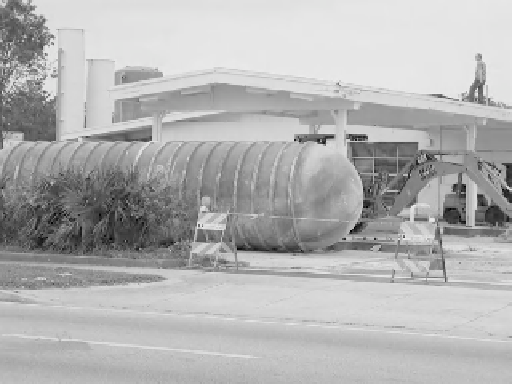Environmental Engineering Reference
In-Depth Information
large area requirement, typically 30 ha (75 ac) of
land per 1000 m
3
/d (0.26 mgd) of treated sewage.
Overland flow systems
treat wastewater as it moves
in graded and maintained grassed and vegetated
sloped areas, and the treated effluent is collected
as residual runoff at the bottom of the slope. Per-
colation of wastewater is not desirable and should
be minimized by selection of low permeability
soils, soil compaction, and/or locating these systems
over an impermeable subsurface stratum. Under
these conditions, the impact of OFSs on ground-
water resources should be minimal. OFSs are
similar to grassed buffer strips used for treatment
of urban and agricultural runoff. nitrogen removal
is accomplished by nitrification-denitrification
processes and depends on the BOD/nitrogen ratio.
If the nitrogen in the influent is primarily in nitrate
form, the removal is minimal.
Rapid infiltration systems
rely on infiltration and fil-
tration of wastewater in permeable soils. If sub-
soils are permeable, the effluent will reach the
groundwater, and if designed improperly, may
become a cause for groundwater contamination.
Removal of contaminants in the upper soil layer
is accomplished by physical-chemical interaction
(adsorption) and biochemical degradation (both
aerobic and anaerobic). Vegetation and its nutri-
ent uptake is not considered. If most nitrogen is in
nitrate form, removal efficiency is greatly reduced.
Figure 5.3.
Gas station storage tank.
shown in Figure 5.3, where the tank is in the foreground
and the gas station is in the background. The relatively
large storage volume for gasoline at a typical gas station
is readily apparent in Figure 5.3. Because there are so
many underground storage tanks and only a small
portion of them are corrosion resistant, the problem of
LUSTs is a major source of diffuse pollution.
5.2.3 Land Application of Wastewater
Land application of waste sludges and treated wastewa-
ter are significant sources of heavy metals, toxic chemi-
cals, and pathogenic microorganisms. There are three
types of systems used in the land application of waste-
water: (1) slow-rate systems (SRSs), (2) overland flow
systems (OFSs), and (3) rapid infiltration systems
(RISs). These are described below.
Problems associated with land application of waste-
water are similar to those for septic tanks; however,
much greater volumes of wastewater are concentrated
in a smaller area. mobile pollutants, such as nitrates, are
of greatest concern; other contaminants (BOD, patho-
genic microorganisms, and phosphates) remain near the
area of application. Bacteria and viruses die off quite
rapidly as wastewater passes through the soil material.
The portion of the aquifer that is recharged by treated
wastewater effluents should not be used as a source of
drinking water, and access should be restricted; water
should be withdrawn at some safe distance from the
recharge area, and monitoring wells should be installed
at appropriate locations to ensure water-quality stan-
dards are met.
Sludge generated by wastewater treatment facilities
is commonly applied to agricultural lands as a fertilizer
and soil conditioner. The effect of land application of
sludge on groundwater quality depends on the transfor-
mation that occurs within the topsoil. Although most of
the toxic metals will be retained by the topsoil, the toxic
metal content of sludge is of concern. Concentrations of
toxic metals in wastewater sludge are much higher than
those in raw wastewater.
Slow rate systems
are most common in the United
States for treatment of municipal wastewater and
effluent reuse in arid areas; in Europe, these
systems have been in use for centuries. The hydrau-
lic loading rate for these systems is mostly matched
to the irrigation and nutrient requirements for
crops and soil permeability. In arid regions, the
hydraulic loading is related to the irrigation
requirement and prevention of salt buildup in
soils. These systems are essentially irrigation
systems and have problems similar to those of
irrigation return flow and its impact on groundwa-
ter and baseflow. Of the three types of land appli-
cation systems, SRSs exhibit the highest nutrient
removal due to the combined effect of nutrient
uptake by crops and attenuation by soils. The dis-
advantage of slow-rate application systems is the

Search WWH ::

Custom Search